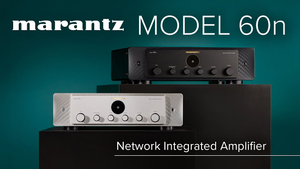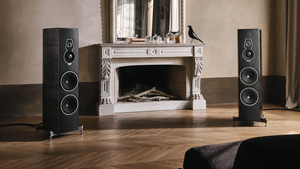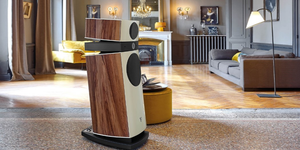
Marantz Model 60n Review:The Modern Amplifier with an Analog Soul
Introduction: Redefining the Integrated Amplifier
In the ever-shifting landscape of high-fidelity audio, the humble integrated amplifier has undergone a profound transformation. Once the stoic gatekeeper of a two-channel system—a simple nexus of source selection, volume control, and power—it has evolved into the central nervous system of the modern home entertainment ecosystem. Today's listener demands a component that can gracefully pivot from spinning a cherished vinyl record to streaming a high-resolution track from a cloud service, and then seamlessly enhance the audio from a blockbuster film, all without a fuss. It is into this demanding arena that Marantz introduces the Model 60n, an integrated amplifier that embodies this new paradigm.
Positioned thoughtfully within Marantz's revitalized stereo lineup, the Model 60n sits as a more accessible yet feature-rich alternative to the premium, Japanese-made Model 40n. It represents a significant leap forward from its well-regarded predecessor, the PM7000N, by embracing a more holistic vision of the amplifier's role in the living room. This ambition has not gone unnoticed; the amplifier has been decorated with accolades, including the prestigious EISA award for "Best Streaming Amplifier 2025-2026," immediately establishing its credentials in a crowded market. The core promise of the Model 60n is compelling: to deliver the brand's signature "Most Musical Sound"—a philosophy steeped in warmth, richness, and emotional engagement—without compromising on the exhaustive connectivity that contemporary life requires.

The inclusion of an HDMI ARC (Audio Return Channel) port is perhaps the most telling feature of the Model 60n's design philosophy. This is more than a mere convenience; it is a strategic declaration of intent. For decades, high-quality television sound has been the domain of complex, multi-channel AV receivers or, more recently, soundbars. By incorporating HDMI ARC, Marantz is directly challenging this status quo, offering a compelling alternative for the discerning listener who prioritizes superior two-channel musicality for all their media but is deterred by the complexity of a full surround-sound setup. The Model 60n is not simply an amplifier that can connect to a television; it is an amplifier explicitly designed to be the elegant, high-performance audio hub for every source in the modern home. This review seeks to determine if it can master this multifaceted role, delivering an experience that is both audiophile-grade and effortlessly intuitive.

Design & Construction: A Legacy in Form and Feel
Exterior Examination
From the moment it is unboxed, the Marantz Model 60n exudes a sense of quality that belies its mid-tier price point. The aesthetic is a masterful blend of the brand's storied heritage and a clean, modern industrial design. The front panel is a two-layer construction, with a robust metal fascia that appears to float above a subtly textured and contoured backplate. This design element, available in either a classic black or a striking silver-gold finish, creates a sophisticated play of light and shadow, lending the unit a visual depth that feels decidedly premium.
The user's primary physical interactions are with the four large rotary dials that control input selection, bass, treble, and volume. These knobs offer a smooth, weighted, and satisfyingly tactile response, reinforcing the impression of a well-engineered component. Central to the design is the iconic Marantz "porthole"—a circular OLED display that pays homage to legendary products like the Model 9 amplifier from the 1960s. While its small size limits the amount of information it can convey—typically just the selected source and volume level—it is crisp, clear, and adds a touch of retro elegance without creating distracting screen glare in a dimly lit listening room.
Internal Architecture
Lifting the Model 60n reveals its substantial 12.7 kg (28.1 lbs) weight, a clear indicator that the premium feel is more than skin deep. A look inside confirms that this heft is a result of deliberate, audiophile-centric engineering. Dominating the internal layout is a large, centrally mounted toroidal power transformer, a component favored in high-end audio for its high current efficiency and low stray magnetic field, which helps to minimize noise. Marantz engineers have strategically placed this power supply away from the sensitive pre-amplifier, digital, and phono stages to prevent interference and preserve the purity of the audio signal.
Further evidence of meticulous design can be found in the large, extruded aluminum heatsink that bisects the chassis, providing ample thermal management for the Class A/B output stage. The digital and phono circuits are housed in their own shielded enclosures, a critical step in isolating delicate, low-level signals from the potential noise generated by the high-current power and digital processing sections. This internal architecture—with its symmetrical PCB layout, use of high-grade, customized components, and extensive shielding—is the physical manifestation of the principles that Marantz claims separate the Model 60n from more generic, feature-led network receivers. It is a design focused squarely on sonic performance.

Manufacturing and Pedigree
An interesting point of distinction within the Marantz lineup concerns the unit's country of origin. Some initial marketing materials and reviews suggested the Model 60n was crafted in the company's renowned Shirakawa facility in Japan, a plant historically reserved for its top-tier models. However, a closer inspection of the rear panel and user reports confirm that the amplifier is, in fact, "Made in Vietnam". This contrasts with the more expensive Model 40n, which is manufactured in Japan.
Rather than being a simple mark against it, this decision should be viewed as a calculated engineering and business trade-off. By leveraging a more cost-effective manufacturing base in Vietnam, Marantz is able to incorporate the expensive, high-performance internal components—the toroidal transformer, the proprietary HDAM modules, the carefully shielded circuitry—while still hitting a competitive price point. The exceptional build quality and finish, praised by reviewers as being on par with more expensive Marantz amplifiers, strongly suggest that this move has not compromised the final product's integrity. The investment has clearly been prioritized for the parts that most directly influence the sound, allowing the Model 60n to deliver a genuinely high-end internal architecture at a more accessible price.

The Complete Connection Suite: From Turntable to Television
A tour of the Model 60n's rear panel reveals a comprehensive and thoughtfully laid-out array of connections that cater to nearly every conceivable audio source, both old and new.

Analog and Digital Inputs
For the traditionalist, the amplifier provides a generous suite of four line-level RCA inputs, suitable for CD players, tuners, or external DACs. Acknowledging the resurgence of vinyl, Marantz has included a dedicated Moving Magnet (MM) phono stage. The company claims to have paid particular attention to this circuit, improving its design to offer a high-quality connection for turntables without the need for an external phono preamplifier.
On the digital front, the 60n is equally well-equipped. It features one optical and one coaxial digital input, allowing for direct connection of sources like a CD transport or a media player. A USB-A port on the rear panel provides another convenient way to play high-resolution audio files directly from a thumb drive or external hard drive.

The HDMI ARC Advantage
The standout feature in the 60n's connectivity suite is its single HDMI ARC input. This single connection fundamentally transforms the amplifier's role in a modern living room. By connecting a single HDMI cable from the 60n to an ARC-compatible television, the amplifier can receive high-quality stereo audio directly from the TV's internal apps (like Netflix or YouTube) as well as any other sources connected to the TV, such as a gaming console or Blu-ray player. Furthermore, support for CEC (Consumer Electronics Control) means that the TV's remote can be used to control the amplifier's volume and power, creating a seamless and intuitive user experience that rivals the simplicity of a soundbar. This single feature makes achieving superior two-channel sound for movies and gaming an effortless, plug-and-play affair.
Outputs and Expansion
Marantz has wisely included features that allow the Model 60n to grow with a user's system. A set of stereo RCA preamp outputs is a crucial inclusion for the aspiring audiophile. This allows the 60n to function solely as a preamplifier and network streamer, with its output feeding a larger, more powerful external amplifier. This provides a clear and valuable upgrade path, ensuring the 60n can remain the heart of a system even as other components are enhanced.
A dedicated mono RCA output is also provided for connecting a powered subwoofer, enabling the creation of a full-range 2.1-channel system for deeper bass impact in both music and movies.
Critical Assessment of Subwoofer Integration
While the inclusion of a subwoofer output is welcome, its implementation reveals a significant and puzzling limitation. The low-pass filter (LPF) for the subwoofer output is fixed at 150 Hz. For proper system integration, a subwoofer should handle only the lowest frequencies that the main speakers cannot reproduce effectively. This typically requires a crossover point set much lower, often around 80 Hz or less, depending on the main speakers. A fixed 150 Hz crossover means there will likely be a significant overlap in frequencies produced by both the main speakers and the subwoofer, which can lead to bloated, boomy, and ill-defined bass. While some adjustment can be made on the subwoofer itself, the lack of a variable crossover in the amplifier is a major oversight for a product aimed at an audiophile audience.
This design choice points to a curious dichotomy in the Model 60n's philosophy. On one hand, the inclusion of preamp outputs caters directly to the audiophile who values future upgrades and system tweaking. On the other, the fixed subwoofer crossover offers a blunt, over-simplified solution that will likely frustrate that same user as their knowledge and desire for system optimization grow. It appears Marantz is attempting to serve both the convenience-focused user and the budding enthusiast in a single product, creating a point of friction where the needs of the two diverge.

Table: Key Specifications
| Category | Specification |
| Amplifier Section | |
| Power Output | 60W per channel ($8 \Omega$), 80W per channel ($4 \Omega$) |
| Amplifier Class | Class A/B |
| Total Harmonic Distortion | 0.02% |
| Damping Factor | $>100$ |
| Frequency Response | $5 \text{ Hz} - 100 \text{ kHz}$ |
| DAC Section | |
| DAC Chip | ESS Sabre ES9018K2M |
| Max PCM Resolution | 24-bit / 192 kHz |
| Max DSD Resolution | DSD256 (11.2 MHz) |
| Key Inputs | |
| Analog | 3x RCA Line-level, 1x MM Phono |
| Digital | 1x Coaxial, 1x Optical, 1x USB-A |
| Network/Video | Ethernet, Wi-Fi, Bluetooth, 1x HDMI ARC |
| Key Outputs | |
| Analog | 1x Stereo Pre-Out, 1x Mono Subwoofer Out |
| Headphone | 1x 6.35 mm (1/4") |
| Physical | |
| Dimensions (W x H x D) | 442 x 129 x 431 mm |
| Weight | 12.7 kg / 28.1 lbs |
The Digital Domain: Navigating with HEOS and Beyond
The digital heart of the Model 60n is the HEOS (Home Entertainment Operating System) platform, a proprietary ecosystem developed by Marantz and its sister company, Denon. This software serves as the command center for all network-based audio functions, from streaming music to managing a multi-room setup.
HEOS as the Hub
Controlled via a free app for iOS and Android, HEOS integrates a number of popular streaming services directly into the amplifier, including TIDAL, Spotify, Amazon Music HD, and Deezer. It also provides access to a vast library of internet radio stations via TuneIn and allows for the playback of high-resolution audio files stored on a local network-attached storage (NAS) drive or a connected USB device. The platform supports a wide range of formats, including lossless FLAC, ALAC, and WAV up to 24-bit/192kHz, as well as DSD files up to DSD256. HEOS also enables the Model 60n to be part of a whole-home audio system, allowing music to be streamed to and from other HEOS-enabled devices in different rooms.
The User Experience
While the HEOS platform is functionally comprehensive and generally stable for core tasks like selecting inputs and grouping rooms, the user experience of the app itself has been a point of consistent criticism. Many professional reviewers and users in online forums describe the interface as cluttered, visually dated, and less intuitive than competing platforms like Sonos or Bluesound's BluOS. Specific complaints often center on a lack of rich metadata presentation (such as detailed artist biographies or album credits) and a more limited selection of natively integrated streaming services compared to some rivals. User forums also contain reports of occasional bugs, connectivity dropouts (which are often tied to the user's home network stability), and an interface that can be confusing to navigate for complex tasks. While a recent update has improved the app's appearance, the consensus remains that while HEOS is serviceable, it is not a market leader in software design.
The Roon Ready Advantage
Fortunately, for the discerning digital audiophile, Marantz has provided a superb alternative. The Model 60n is certified "Roon Ready," a feature that many reviewers consider a crucial value-add and a "fallback for demanding audiophiles". Roon is a subscription-based music management and playback software renowned for its rich interface, extensive metadata integration, and powerful library organization tools. When a device is Roon Ready, it can act as a high-quality network endpoint, receiving a pristine audio stream directly from the Roon Core (the user's server). This allows the user to bypass the HEOS app entirely, using Roon's universally praised interface for all music browsing and playback control. This single feature significantly elevates the 60n's appeal, transforming it from a device with a merely adequate app into a first-class component within a state-of-the-art digital ecosystem.
This dual-platform approach appears to be a deliberate strategy. By providing the functional-but-imperfect HEOS app, Marantz caters to the mainstream user who expects built-in streaming capabilities. Simultaneously, by including Roon Ready certification, they provide an essential "escape hatch" that satisfies the more demanding audiophile segment, who might otherwise dismiss the product based on its native software experience.

Alternative Connections
Beyond HEOS and Roon, the Model 60n offers a host of other convenient ways to stream audio. It supports Apple AirPlay 2, allowing for easy streaming from any Apple device. Spotify Connect and TIDAL Connect let users control playback directly from the native apps of those services, which many find more familiar and responsive than using HEOS. Finally, a standard Bluetooth connection provides a quick and universal method for guests to share music from their phones. This multi-faceted approach ensures that no matter the user's preference or technical comfort level, there is an easy way to get music playing.

Sonic Performance: The Most Musical Sound
Ultimately, an amplifier is judged by how it sounds, and it is here that the Model 60n makes its most compelling case. It is an amplifier that is, first and foremost, a very good stereo amplifier, engineered to deliver the signature Marantz sound.
The Marantz House Sound
Across numerous reviews, a consistent sonic portrait emerges. The Model 60n's presentation is described with terms like "lush," "organic," "warm," "smooth," and "euphonious". This is not a sound that strives for sterile, analytical neutrality. Instead, it is a deliberately voiced character that prioritizes musical engagement, emotional connection, and long-term listenability. It is a sound designed to be enjoyed for hours on end without causing fatigue, a quality achieved through the use of Marantz's proprietary Hyper Dynamic Amplifier Modules (HDAMs) and a classic Class A/B amplification topology. It is a presentation that is forgiving of less-than-perfect recordings, often imbuing them with a pleasing warmth and coherence.
Frequency Spectrum Analysis
Breaking down the sonic signature reveals a carefully balanced profile. The bass is often noted as having a "slight bloom" or a touch of overemphasis, lending a sense of weight and richness to the sound. However, this warmth does not come at the expense of control; the low end is described as "rigorously controlled," rhythmic, and textured. While it can dig deep with authority when paired with capable floorstanding speakers, its power is characterized as potent rather than "monstrously so".
The midrange is consistently highlighted as a particular strength. Vocals are rendered with an intimacy and presence that is both "direct" and "characterful". This "cosy portrayal" brings the listener closer to the performance, making for a deeply engaging and relaxing experience, especially with vocal-centric music.
In the upper frequencies, the 60n exhibits a deliberate "rounding off of high-frequency extension". This contributes to its smooth, non-aggressive character, ensuring that even bright or poorly recorded material is rendered without harshness or sibilance. While this means it may lack the last scintilla of top-end sparkle compared to more clinical-sounding amplifiers, it is a key component of its fatigue-free and pleasant presentation.
Technical Performance
Despite its warm and polite demeanor, the Model 60n is no slouch in the technical department. It is capable of creating a "large and properly defined soundstage," giving instruments and voices ample space to breathe. Detail retrieval is high, allowing the amplifier to unearth subtle nuances, transient details, and different sonic planes within a recording. While some reviewers characterize its personality as "cultured" or "edging towards laidback," they are quick to point out that it is not sluggish. When the music demands it, the 60n can convey a convincing sense of speed, rhythm, and dynamic excitement, handling the frenetic crescendo of a classical piece with the same composure as a driving rock track.
System Synergy: The Crucial Partnership
A recurring theme in evaluations of the Model 60n is the critical importance of system matching, particularly speaker selection. The amplifier's inherent warmth is a strong sonic filter that will color the final sound of any system it is a part of. This is a double-edged sword. On one hand, its forgiving nature can tame overly bright speakers or smooth out aggressive recordings. On the other hand, if paired with speakers that are themselves warm, rich, or laid-back—especially in an acoustically damped room with thick carpets and heavy furniture—the resulting sound could lack resolution, openness, and dynamic verve.
One review vividly illustrates this point, noting that while a pairing with DALI speakers was enjoyable and enveloping, the performance "opened up significantly" when switching to a pair of the more neutral and revealing Bowers & Wilkins 705 S3 Signature speakers. This demonstrates that a prospective buyer is not just purchasing a neutral component; they are investing in a specific sonic philosophy. The ultimate success of that investment hinges on their willingness and ability to build a synergistic system around the 60n's distinct personality. For those seeking maximum transparency and dynamism, pairing it with speakers that are neutral-to-bright is highly recommended to achieve the most balanced and engaging result.
The Competitive Field: Finding Its Place
The Marantz Model 60n enters a fiercely competitive market segment, priced at approximately $1,600 USD. To understand its value, it must be compared against key rivals that offer different combinations of features, power, and sonic philosophy.

vs. Marantz Model 40n
The most direct comparison is with the 60n's bigger brother, the Model 40n. Priced significantly higher, the 40n justifies its cost with more power (70W vs. 60W per channel), a more sophisticated internal component selection, a superior chassis, and the prestige of being manufactured in Japan. The Model 60n's role is clear: it is the high-value proposition. It delivers the vast majority of the 40n's extensive feature set and a large measure of its sonic DNA for a much more accessible price, making it the logical choice for those who want the modern Marantz experience without stretching to the premium tier.
vs. Yamaha R-N800A
The comparison with the Yamaha R-N800A is a classic battle of sonic philosophies. The Yamaha is often characterized by a more neutral, clean, and clinical sound, in contrast to the Marantz's signature warmth and musicality. The Yamaha's trump card, however, is technical: it includes the proprietary YPAO (Yamaha Parametric room Acoustic Optimizer) room correction system. This feature allows the amplifier to measure the listening room's acoustics and apply digital equalization to smooth out frequency response issues, a powerful tool that the Marantz entirely lacks. The choice for a potential buyer is stark: the curated, engaging musicality of the Marantz versus the customizable, room-corrected precision of the Yamaha.
vs. Cambridge Audio CXA81
Pitting the Model 60n against the Cambridge Audio CXA81 highlights its identity as a truly integrated, all-in-one solution. The CXA81 is a highly decorated traditional Class A/B integrated amplifier, lauded for its powerful (80W per channel), dynamic, and insightful sound. However, it is a purist design, lacking any built-in network streaming capabilities or an HDMI ARC input. To match the functionality of the Model 60n, a CXA81 owner would need to purchase a separate network streamer, such as a Bluesound Node or WiiM Pro, adding cost and complexity to the system. In a telling user review, one owner who moved from a CXA81 to the Model 60n reported "enjoying the Marantz far more," citing its all-in-one convenience and warm, engaging sound as the deciding factors.
The Model 60n's unique selling proposition becomes clear through these comparisons. It is not trying to be the most technically advanced amplifier like the Yamaha, nor the most powerful purist amplifier like the Cambridge Audio. Its strength lies in its masterful synthesis of both worlds. It occupies a strategic middle ground, refusing to force the user to choose between a classic, musical hi-fi sound and a complete suite of modern, convenient features. For the listener who wants both in a single, elegant chassis, the Model 60n stands almost in a class of its own.
Final Verdict
The Marantz Model 60n is a resounding success, a product that understands and expertly serves the needs of the modern music enthusiast. It is a superbly built and aesthetically pleasing integrated amplifier that masterfully blends the classic, warm, and engaging Marantz sound with a truly comprehensive suite of contemporary features. It is, as multiple reviewers have concluded, an "extremely capable do-it-all" component that feels equally at home streaming a high-resolution playlist as it does spinning a record or elevating the sound from a television.
Its strengths are numerous and compelling. The sonic performance is rich, musical, and endlessly listenable. Its connectivity is class-leading, with the inclusion of HDMI ARC being a game-changing feature for integrating high-quality audio into a living room setup. The build quality instills a pride of ownership, and the provision of both Roon Ready certification and preamp outputs ensures it can satisfy demanding audiophiles and provide a clear path for future system upgrades.

However, it is not without its compromises. The native HEOS app experience, while functional, lags behind the slickness and depth of its best competitors, making the inclusion of Roon Ready feel less like a bonus and more like a necessity for some users. The most significant and puzzling flaw is the fixed 150 Hz subwoofer crossover, an uncharacteristic oversight that complicates precise bass integration and feels at odds with the amplifier's otherwise audiophile-grade ambitions. Finally, its distinct sonic personality, while a major part of its charm, demands careful speaker matching to truly shine and avoid a presentation that could become overly smooth or lacking in resolution.
The ideal user for the Model 60n is therefore clearly defined. It is not for the measurement-obsessed purist who demands absolute neutrality, nor is it for the home cinema tinkerer who requires granular control over every audio parameter. Rather, the Model 60n is for the modern music lover who places a premium on convenience, elegant design, and a sound that is fundamentally rich, warm, and engaging. It is the perfect heart for a high-quality, versatile 2.1-channel system that will be called upon daily to play music from any source and to elevate the experience of watching movies and television. For this listener, the Marantz Model 60n is more than just a formidable arrival at its price point; it is one of the most compelling, complete, and musically satisfying solutions on the market today.






Comments